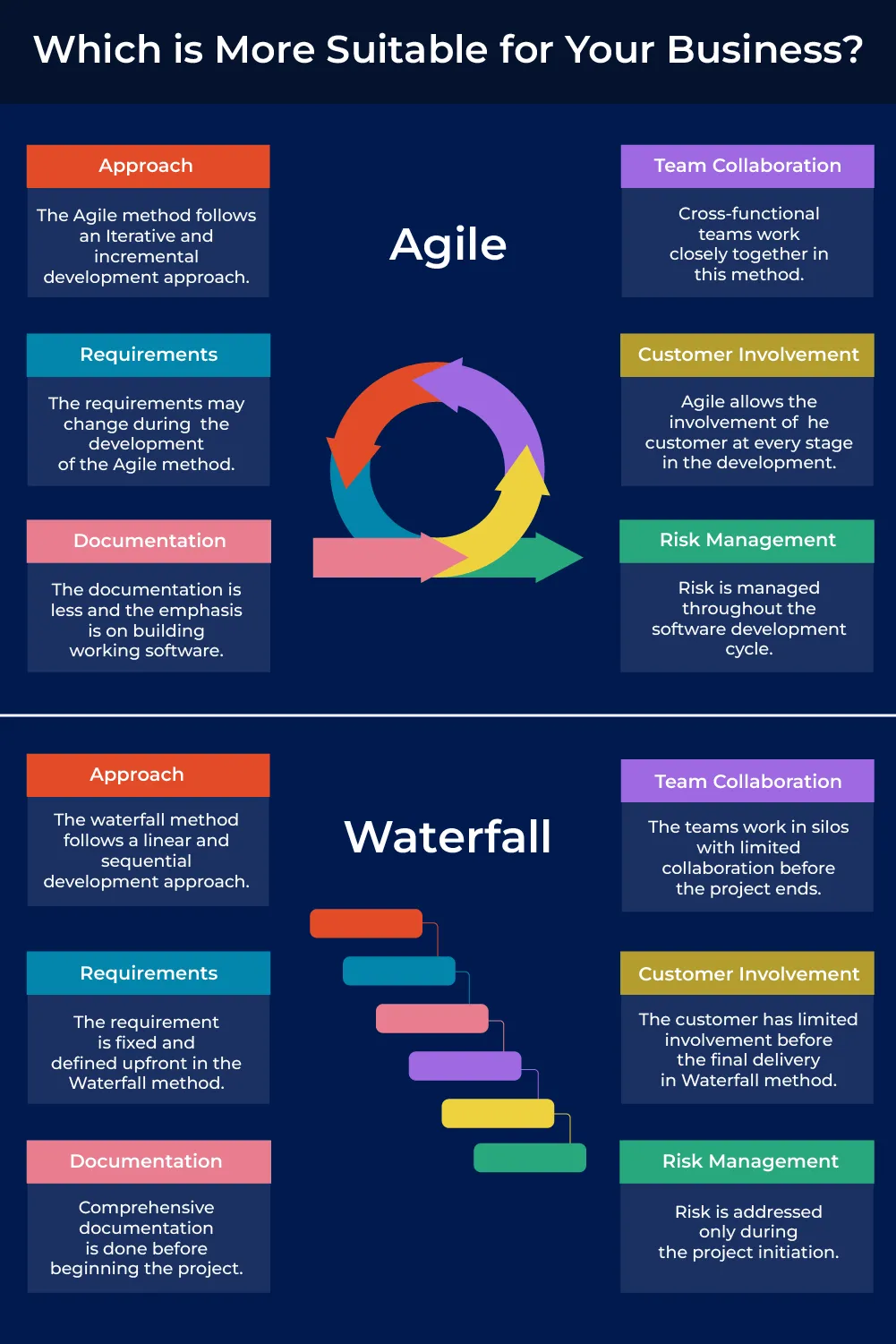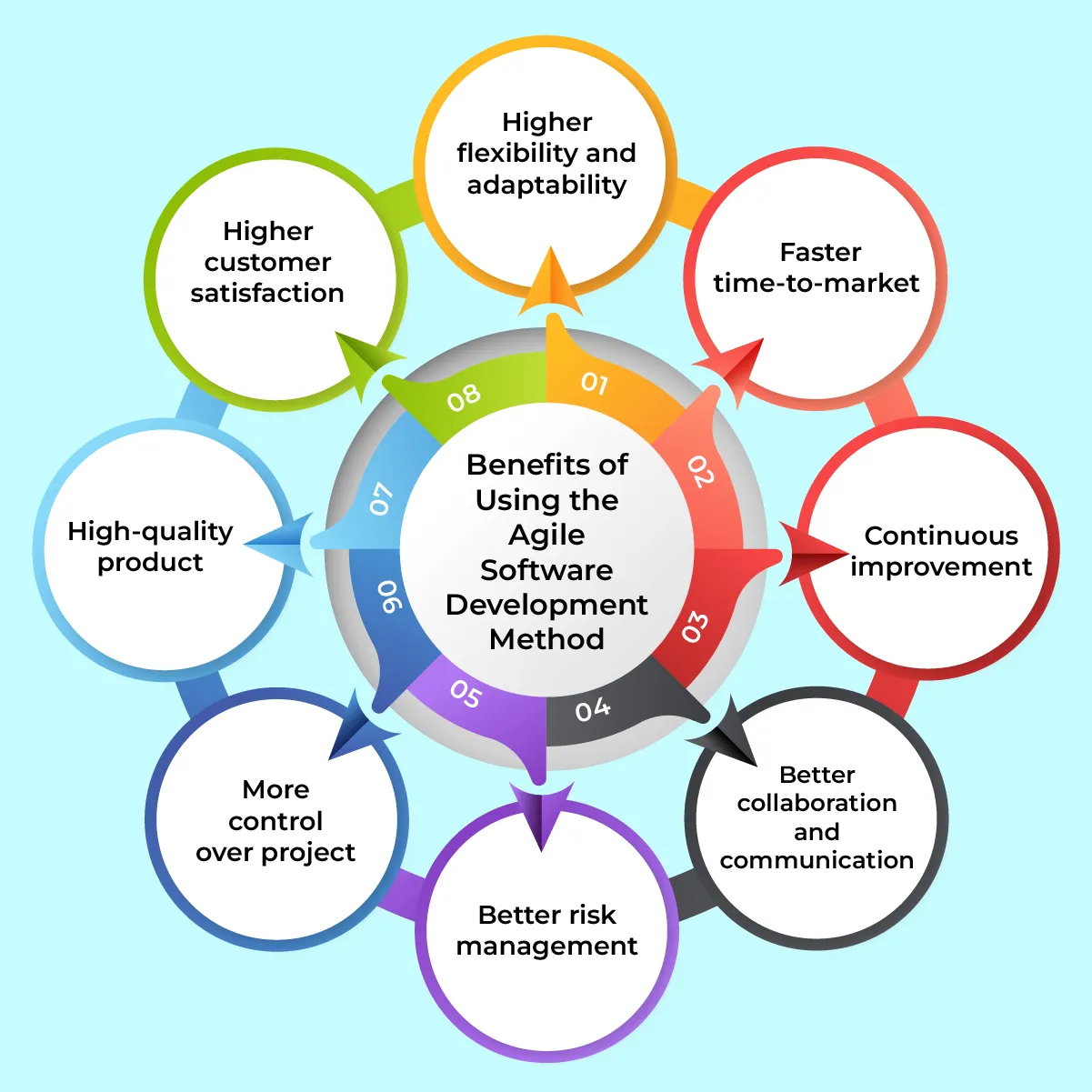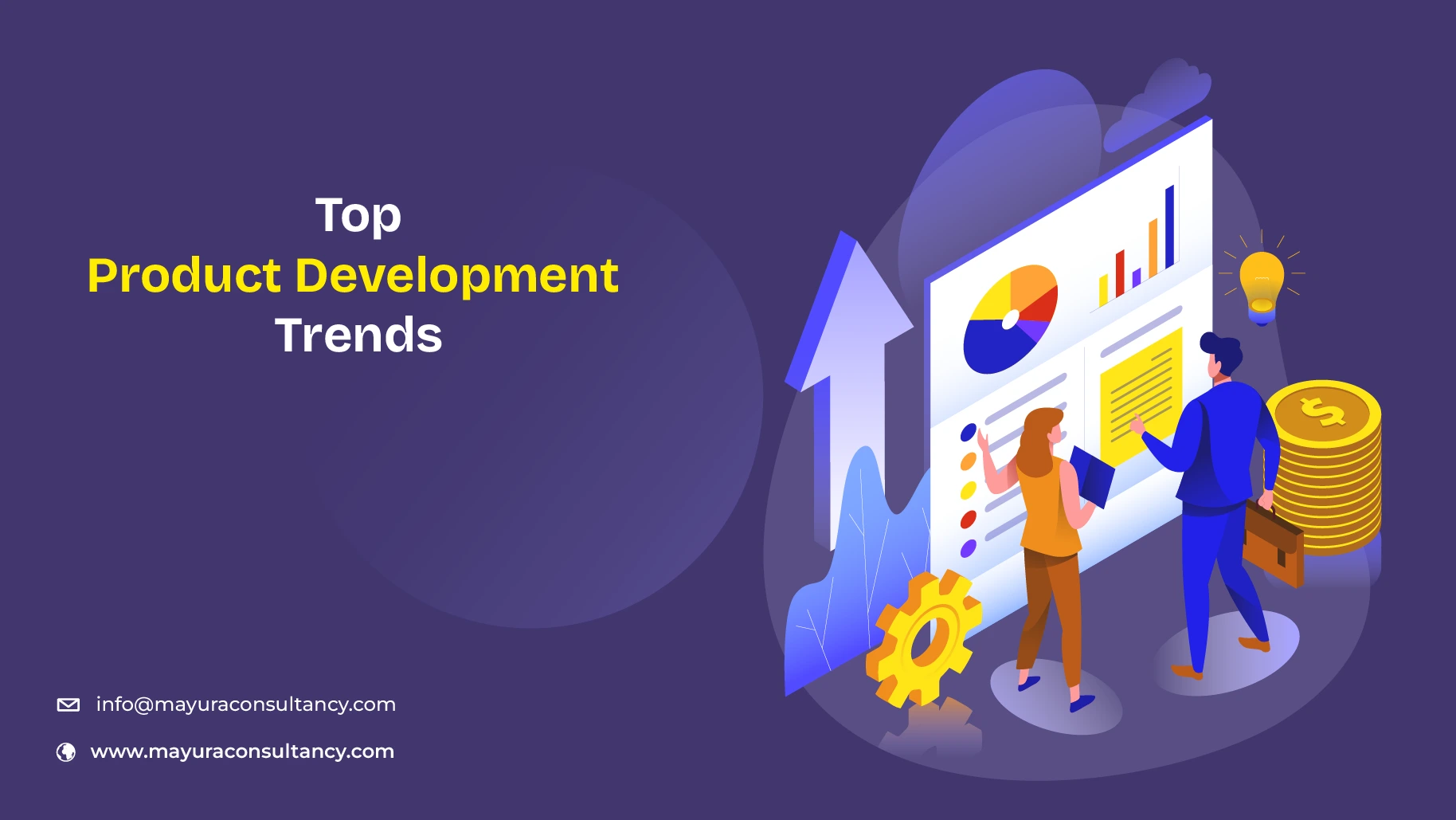Software development used to be a complicated and rigid process before the introduction of the Agile development method. Imagine your development team has started working on the project based on comprehensive planning and design.
But in the midway, you realize you need to add a new feature due to changing business demands. It will again require planning and design. So, what’s the solution?
The answer is the Agile development method. So What exactly is Agile software development and what are its benefits? Let’s dive in.
This Article Contains:
What is the Agile Software Development Methodology?
Agile is a software development method that provides continuous delivery of working software developed in quick iterations. Each iteration is usually between 2-4 weeks, depending on the project requirements.
In the Agile process, the development team starts with a small portion of work instead of wasting hours and days in creating a comprehensive plan that may not be suitable while executing the project.
This methodology welcomes changes at any stage in the development process and focuses on continuous improvement to ensure the project meets the client's and users' expectations.
How Does Agile Software Development Work?
The Agile software development methodology follows a series of steps to be performed one after the other. It helps the development team achieve the desired goals while allowing room for changes during the agile software development cycle. Let's have a look at how agile software development works.
1. Project Initiation
This step involves gathering information about the business's requirements, defining the project scope, objectives and prioritizing which steps to take first. It also includes creating a backlog of the essential features, and the tasks to be completed.
2. Sprint Planning
The next step in the Agile approach is breaking down the project into smaller and manageable parts. This includes prioritizing the most essential tasks and estimating the time required to complete each iteration.
3. Development
In this stage, the development team writes the codes and performs testing to ensure the software functions properly according to the business requirements and meets the users' expectations.
4. Continuous Integration and Testing
This step involves integrating and updating the code changes frequently in the shared repository and testing them to identify errors and bugs early in the development process. It ensures the software remains functional and meets the quality standard set by business owners.
5. Daily Meetings
This is an integral part of the Agile software development method, which is also known as daily Scrums. These meetings allow every team member to update about the progress of their work, and remove any bottlenecks. Since the project owner is also a part of the meetings, it ensures the project is progressing in the right direction.
6. Sprint Review
At the end of each iteration, the team conducts a review meeting to demonstrate the work and the outcome to all the stakeholders, including designers, developers, and the product owner. The team also gathers feedback on their work for any scope of improvements.
7. Sprint Retrospection
The team also reflects on their work - what went well and what could be improved in the next sprint. Retrospection provides an opportunity to continuously improve the sprint process and ensure the team incorporates the learnings in the next iteration.
8. Repeat
In the Agile development method, the steps are repeated in a loop throughout the project till the desired result is achieved. The backlog is also updated regularly to adapt to the changing requirements.
Agile vs. Waterfall - Which is More Suitable for Your Business?
Agile and Waterfall are two project management methodologies. Before the Agile method, software developers were using the Waterfall methodology. Waterfall is a traditional approach to managing projects, involving a linear flow, where one step follows the other.
In the Waterfall method, the team has to complete one step before moving to the next. On the other hand, the Agile process allows the team to work on different phases simultaneously, making it more flexible and adaptable.
So, which methodology is the best for your project?
Waterfall is suitable for projects with well-defined project scope, timelines, and budgets. However, this method follows a relatively rigid structure, which may not be ideal for building complex software that demands late changes.
The agile method was developed to incorporate unexpected changes during the development process since software projects can take years to complete and customers' demands may change by then. Agile is a better option for projects with evolving requirements, rapid delivery of working software, and regular involvement of clients during development.
Let’s look at the major differences between Agile and Waterfall methods so that you can choose the right one for your project.

8 Benefits of Using the Agile Software Development Method
Agile methodology is popular for software development due to its numerous benefits. Let us look at why agile development is important.

1. Higher Flexibility and Adaptability
The agile development process is more flexible than other methodologies as it allows changes anytime, even at the last moment. An Agile development team can respond to the changing client and user requirements quickly and more effectively.
If you are a business owner, you can ask the team to add or remove features or make improvements throughout the development process, ensuring the end product meets the business demands and users’ expectations. This approach increases the business’ ability to respond to the dynamic market demands and helps to stay competitive and relevant.
2. Faster Time-to-Market
Agile methodology breaks down the software project into smaller and manageable parts called iterations, usually two to four weeks. Each iteration delivers a potentially shippable part, delivering essential and independent features quickly.
It accelerates the development process by significantly reducing the time for extensive planning and design, resulting in faster time to market and maximizing the return on investment.
3. Continuous Improvement
The flexible nature of Agile methodology permits continuous improvement during the software development lifecycle. This approach allows product owners to provide regular feedback and valuable insights to the development team and ensure they implement the changes.
Besides continuous innovation, which helps businesses adapt to the changing market dynamics, ensuring long-term sustainability and success.
4. Better Collaboration and Communication
The agile method facilitates regular communication among team members throughout the development process. The stakeholders and the development team engage before, during, and after every sprint through daily standup meetings and a review at the end of each iteration.
Moreover, tools like Jira, Trello, Asana, and Slack, play a critical role in the Agile process enabling team members to manage tasks, track progress, and communicate more effectively to remove any bottlenecks quickly.
5. Better Risk Management
Another advantage of using Agile methodology is it significantly reduces the risks, which is critical for businesses. This method offers an adaptive approach that allows changes according to the user demand during the development.
Additionally, the frequent release of functional software helps businesses identify issues and get them sorted before they become problems after the launch, reducing the risk of project failures and saving costs.
6. More Control over Project
The iterative process in Agile development provides more control to the business owners. You are a part of the daily meeting and the review at the end of each iteration. This allows you to track progress throughout the development process. If you have any concerns or you want to share feedback, you can do that anytime. Moreover, Agile allows changes anytime, providing you with more control over the project.
7. High Quality Product
The Agile method breaks down the complete projects into short iterations. It enables developers to build small functional parts that can be tried before the final release. Continuous integration and testing help in identifying and addressing issues promptly and efficiently instead of building the product at one go and then trying to rectify the errors.
This significantly improves the product quality and reduces the chances of major defects after the completion, thus minimizing the need for rework and expensive post-deployment support.
8. Higher Customer Satisfaction
The agile process allows you to demonstrate your products to the customers and take their feedback. This enables you to make the required changes and ensure the software meets your users' needs.
Furthermore, the Agile method allows the integration of new features, functionalities, and technologies based on current and future trends, so that the product remains relevant and meets evolving users’ expectations. It not only enhances customer satisfaction but builds a loyal customer base.
Top Agile Frameworks for Software Projects
Agile software development frameworks are a set of principles and practices that focus on collaboration, communication, continuous feedback, and improvements to ensure the end product meets the business expectations. Let's look at popular Agile frameworks.
1. Scrum
Scrum is one of the most popular Agile methodologies that focuses on breaking down the project into multiple parts known as 'Sprints.' At the end of each Sprint, the team will review the progress and share feedback before initiating the next Sprint.
Scrum methodology ensures flexibility, transparency, and frequent delivery of valuable software, leading to faster time-to-market, and enhance stakeholder satisfaction.
2. Kanban
Kanban is an Agile project management method that simplifies workflow and enables continuous delivery of quality products. Kanban projects are managed through a Kanban board that segments the tasks into three columns: “To Do,” “In Progress,” and “Done.” It limits the number of ‘in progress’ tasks, helping the team to focus on the most important tasks and avoid overload.
Kanban's visual workflow, continuous improvement, and focus on the most important tasks lead to increased efficiency and faster delivery.
3. Extreme Programming
Extreme Programming, also known as "XP," is an agile approach that focuses on continuous development and delivery and it includes sprints or iterations like the Scrum methodology. XP demands close teamwork between the developers and the customer, continuous planning and testing, and rapid feedback loops. The core values of XP are:
Simplicity
Communication
Feedback
Courage
Respect
The methodology works best for small, close-knit teams with clear goals and open communication. If you want to build flexible and high-quality software, XP can be your magic formula.
4. Lean
Many people mistake Lean methodology for Agile, but that's not right. The lean framework came from Lean Manufacturing, developed by the Japanese in the 1980s, and includes a set of managerial principles.
Lean software development emphasizes optimizing efficiency, eliminating waste, and delivering only what the product needs. If you are looking to manage an agile development process in a short timeframe, this methodology can be a good option.
Wrapping Up
The Agile method has significantly transformed software development by providing the flexibility to make changes and allowing the development team to build high-quality and efficient software that meets customer expectations. Moreover, by shortening development timelines, Agile ensures faster delivery of reliable products and reduces development costs and time, benefiting businesses.
However, applying Agile methodology requires experience and efficiency. If you are looking to apply Agile development for your software project, Mayura Consultancy Services can be your ideal partner. Join us to implement the most effective and flexible software development methodology for your project.
FAQs
1. What is Agile software development and how will it benefit my business?
Agile software development is an iterative software development approach that focuses on client involvement throughout the development process and offers the flexibility to make changes anytime during development. It allows faster delivery of working software and offers better adoption to the changing requirements, increasing customer satisfaction.
2. How does the Agile method adapt to the changing business requirements?
The agile software development method allows the reassessment of priorities during the development process. This makes it easier to add new features and functionalities anytime, even at the last moment.
3. How does the Agile development method ensure quality?
The agile development method focuses on testing throughout the development process, which minimizes the chances of errors, and bugs, ensuring a better quality software product compared to other development methods.
4. Is the Agile development process faster?
Yes, the Agile development method focuses on delivering working software rather than spending time on comprehensive planning and documentation, making it faster than other processes.







Comments
Share Your Feedback
Your email address will not be published. Required fields are marked *